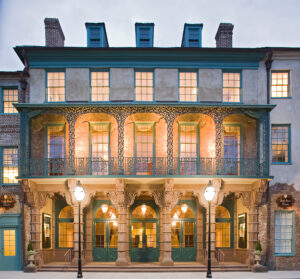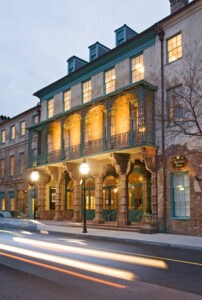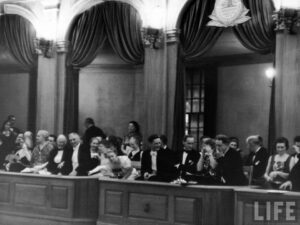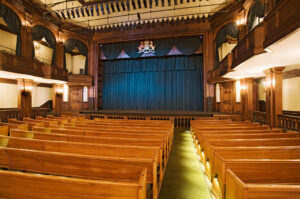As perhaps the most beloved venue at Spoleto, the Dock Street Theatre will continue to charm this year with an exciting lineup for the 2023 Festival. Situated in the heart of historic downtown Charleston, this stunning theater accommodates a range of programming, with a performance space suited for everything from larger-than-life cabaret reminiscent of a big city production, to intimate pieces like the compelling one-person performance of An Iliad. For both first-time and returning Spoleto Festival USA attendees, here are six hidden secrets about the Dock Street Theatre that you can bring with you to the Festival this year.
#1 America’s first purpose-built theater suffered a tragic fate.
Built in 1736, the Dock Street Theatre was the first theater in America solely designed for theatrical performances, and it opened with its debut performance of The Recruiting Officer, a play by George Farhquar. However, the original structure was short-lived; it was destroyed in the great fire of 1740 after just two years of operation.

#2 The Dock Street Theatre is not located on Dock Street!
Despite its name, the Dock Street Theatre is located on Church Street in Charleston and was once a hotel, today the last remaining antebellum hotel in the city. It was constructed in 1809 by Alexander Calder and his wife, who renovated the existing structures on the site and named it Planter’s Hotel, for the planters who frequented the hotel during horse racing season when they visited from the midlands of South Carolina. Its façade was improved in 1835 with its cast-iron balcony and later its sandstone columns, all en-vogue during the early 19th century. Charleston’s famed drink, Planter’s Punch, which was introduced at the hotel.

#3 A father of a famous assassin went on a rampage at the Planter’s Hotel.
Junius Brutus Booth, father of John Wilkes Booth and a famous actor himself, once stayed at the Planter’s Hotel, a favored location for the various theater troupes visiting Charleston. The elder Booth famously attacked the hotel’s manager one night in a fit of rage after a performance, almost killing him.
#4 It was rebuilt…but mother nature had other plans.
The period of prosperity for the Planter’s Hotel came to an end following the Civil War. The hotel suffered from the city’s struggling economy, and the 1886 Charleston earthquake caused further damage. The building required extensive repairs, far beyond any individual’s undertaking. At the turn of the century, the building was left to decay.

#5 Abandoned for decades, a hotel was rescued.
Plans to renovate what had been the Planter’s Hotel emerged in the mid-1930s when the Works Progress Administration, which was created during the Great Depression to generate employment, announced its intention to renovate the condemned structure. Instead of reopening it as a hotel, however, the building was repurposed as a theater and modeled after those in 18th-century London. The woodwork inside was carved from native cypress that had been salvaged from other Charleston antebellum mansions.

#6 Charleston’s Dock Street Theatre, with nearly 350 years of history, is host to countless ghosts.
The most commonly sighted ghost at Dock Street Theatre is Nettie, who is said to have frequented the Planter’s Hotel in its heyday . Legend has it that she perished in the hotel—standing on a balcony that was struck by lightning. Nowadays, Nettie’s ghost is said to wander aimlessly throughout the Dock Street Theatre. Many that have witnessed the spirit describe her as wearing a tattered red dress.

